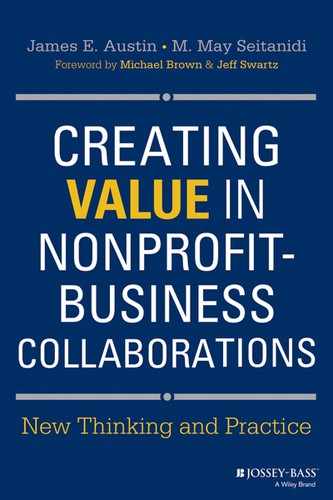Preface
Over the past thirty years, collaboration between nonprofits and businesses has evolved, in some ways to the point of revolution. Cross-sector collaboration has moved from being a nice thing to do to being a necessary component of strategy and operations. It is difficult to find an important company or nonprofit that is not engaged in such cross-sector collaboration. In the world of nonprofits and businesses, collaboration has become essential to success.
Simultaneously, research into cross-sector collaboration has burgeoned. Its social and managerial importance as well as its conceptual and operational complexity are attracting intellectual attention from a wide range of disciplines throughout the world. Scholars have created international associations focused on this rapidly emerging field of study, and conferences on cross-sector collaboration have proliferated.
Over these last three decades, we have been deeply engaged, as researchers and as authors, in the study of cross-sector collaboration and have interacted extensively with collaborating partners in business and nonprofit groups. The seeds for this book were planted in 2000 with James E. Austin’s publication of the article “Strategic Collaboration between Nonprofits and Business” in the Nonprofit and Voluntary Sector Quarterly (NVSQ)1 and with the subsequent publication of his award-winning book The Collaboration Challenge: How Nonprofits and Businesses Succeed through Strategic Alliances.2 Over the subsequent years, both of us have continued to conduct research and to publish on the increasingly complex phenomenon of cross-sector collaboration.
In 2011, the editors of NVSQ asked us to review the cumulative literature on collaboration between nonprofits and businesses, and to ascertain what had been learned since the turn of the twenty-first century. This request led us to conduct an exhaustive examination of the literature, an undertaking that revealed significant advances in collective knowledge of the field along with some equally significant gaps in collective understanding of how value is created in cross-sector partnering. Our immersion in that literature review led us to conceptualize a new framework for thinking about and analyzing value, and we presented our Collaborative Value Creation (CVC) Framework in two lead articles that were published in consecutive issues of NVSQ at the end of 2012.3 The journal’s editors offered the following comments on that work:
Their fine effort [has] yielded much more than a review. From their in-depth and broad examination of the cross-sector collaboration and corporate social responsibility . . . literature they [have] identified various inadequacies in the way value was treated, and consequently they [have] formulated a substantive and important new framing and extension of the current literature . . . Collaborative Value Creation constitutes a central mechanism for addressing complex social issues and for generating multi-value creation leading to societal betterment. In these times of rising needs and diminishing resources, identifying insights into the way value is created, treated, and distributed requires deeper understanding and more systematic research that can lead to a paradigm change of what constitutes value. We believe that these articles will help move us in this direction by stimulating further thinking and investigation in this important emerging field.4
The subsequent positive feedback on those articles that we received from academic colleagues and practitioners, along with the enthusiastic encouragement of our editor at Jossey-Bass, led us to plan and write this book. That process also enabled us to elaborate, refine, extend, and test our original Collaborative Value Creation Framework and to illustrate its features with examples from practice.
We have attempted to make this book particularly relevant and accessible to practitioners while retaining many details of our base research and intellectual work. Nevertheless, the book was not written exclusively for an audience of practitioners. Although it does draw on, distill, and communicate key findings from the rich collaboration literature, it also presents a new conceptual and analytical framework for co-creating value, a framework that managers can apply. To that end, practical applications of the concepts discussed in the book are illustrated by a multitude of examples taken from actual collaborations. The book’s hundreds of references to our underlying research serve as a guide to even more detailed knowledge resources on subjects of particular interest to readers.
In addition, because we recognize that many readers are likely to be collaboration scholars in search of a book to use in their own research or teaching, we have presented a wide range of examples from all over the world. We have also included a set of five questions for reflection at the end of Chapters Two through Seven, with the first three questions intended primarily for practitioners and the last two intended more for scholars and students. The questions invite readers to think about the important new concepts that the CVC Framework puts forward, and about its broader implications for organizations, individuals, and society. In Chapter Seven, the final chapter, we offer a set of twelve guidelines for practitioners in nonprofits and business who are involved in designing and managing strategic cross-sector partnerships aimed at generating ever-higher levels of planned and emergent collaborative value.
Collaboration itself can be empty. The premise of this book is that cross-sector collaborations should be designed and managed to create economic, social, and environmental value for individuals, organizations, and society. In order for those goals to be realized, it is vital that we deepen and broaden our collective understanding and practice of co-creating value.
James E. Austin
M. May Seitanidi
Notes
1. Austin, 2000d.
2. Austin, 2000b.
3. Austin and Seitanidi, 2012a; Austin and Seitanidi, 2012b.
4. Handy, Brudney, and Meijs, 2012, p. 721.
